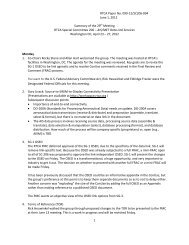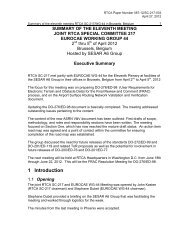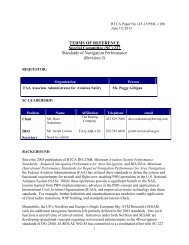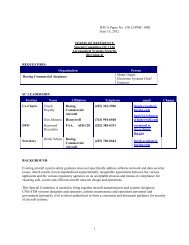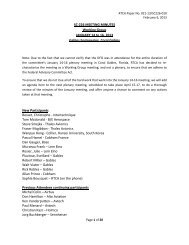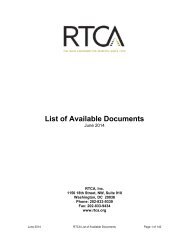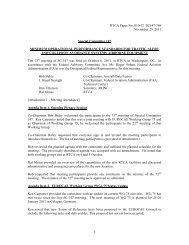2009 Annual Report - RTCA
2009 Annual Report - RTCA
2009 Annual Report - RTCA
Create successful ePaper yourself
Turn your PDF publications into a flip-book with our unique Google optimized e-Paper software.
for FIS and AIS functions that support the global<br />
aeronautical information management concept.<br />
SC-205, Software Considerations is developing<br />
updates to three documents: DO-178B,<br />
DO-248B, and DO-278. These updates will<br />
continue the current objective-based approach<br />
and technology-independent nature of software<br />
assurance for the continued safe implementation<br />
of aeronautical software. The updated documents<br />
will consolidate software development<br />
guidance and guidelines to provide clear and<br />
consistent ties with the systems and safety processes,<br />
address emerging software trends and<br />
technologies, and implement a process that can<br />
change with the technology. SC-205 is expected<br />
to complete its work in early 2011.<br />
SC-203, Unmanned Aircraft Systems (UAS)<br />
is developing standards, certification criteria, and<br />
procedures for sense and avoid systems as well<br />
as protocols to be used for the certification of<br />
command, control, and communication systems<br />
in the defined flight environment. Many federal<br />
agencies and commercial operators are currently<br />
operating or seeking authority to operate UAS<br />
in the National Airspace System (NAS). SC-203<br />
products will help assure the safe, efficient, and<br />
compatible operation of UAS with other vehicles<br />
operating within the NAS.<br />
SC-186, Automatic Dependent Surveillance-Broadcast<br />
(ADS-B) is developing<br />
operational requirements and minimum performance<br />
standards for airborne and ground<br />
user applications of ADS-B. Over 70 ADS-B<br />
operational capabilities have been identified<br />
that could provide enhanced safety, increased<br />
capacity, and improved efficiency. In <strong>2009</strong>, four<br />
<strong>RTCA</strong> documents (DO-260B, DO-282B, DO-317,<br />
and DO-318) related to Automatic Dependent<br />
Surveillance-Broadcast (ADS-B) applications<br />
were published. The publication of DO-260B<br />
and DO-282B was particularly significant because<br />
the FAA issued a Technical Standard Order<br />
referencing these documents the day they were<br />
approved.<br />
SC-159, Global Positioning System (GPS)<br />
is developing minimum standards that form the<br />
basis for FAA approval of equipment using GPS<br />
as a primary means of civil aircraft navigation.<br />
In <strong>2009</strong>, SC-159 completed work on DO-316,<br />
which provides recommended MOPS for singlefrequency<br />
airborne navigation sensor equipment<br />
not augmented by ground or space-based<br />
systems. DO-316 reflects absence of Selective<br />
Availability (SA), updated RAIM (Receiver Autonomous<br />
Integrity Monitoring), and an updated<br />
signal interference environment.<br />
SC-147, Traffic Alert & Collision Avoidance<br />
System (TCAS) has defined and updated the<br />
TCAS and TCAS II performance standards, thereby<br />
contributing to one of the most significant advances<br />
in aviation safety in the past twenty years.<br />
In <strong>2009</strong>, two publications (DO-300 Change 1 and<br />
DO-185B Change 1) provide updated recommended<br />
requirements for the Traffic Alert and<br />
Collision Avoidance Systems II (TCAS II) related<br />
to the TCAS II hybrid surveillance capability and<br />
other performance updates.<br />
SC-135 Environmental Testing is continuing<br />
to maintain and update <strong>RTCA</strong> DO-160,<br />
Environmental Conditions and Test Procedures<br />
for Airborne Equipment. This document is the<br />
international de facto standard for environmental<br />
testing of commercial avionics and provides a<br />
laboratory means to determine the performance<br />
characteristics of airborne equipment.<br />
<strong>2009</strong> <strong>Annual</strong> <strong>Report</strong> • <strong>RTCA</strong><br />
11




